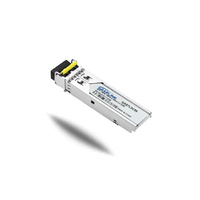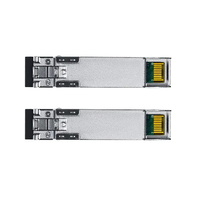QSFP 40G 1310nm 40km LC Transceiver
Specifications
GLQ5L0C31 is designed to operate over single-mode fiber system using 4X10 CWDM channel in 1310 band and links up to 30km. The module converts 4 inputs channel of 10Gb/s electrical data to 4 CWDM optical signals, and multiplexes them into a single channel for 40Gb/s optical transmission. Reversely, on the receiver side, the module optically de-multiplexes a 40Gb/s input into 4 CWDM channels signals, and converts them to 4 channel output electrical data.
The central wavelengths of the 4 CWDM channels are 1271, 1291, 1311 and 1331 nm. It contains a duplex qsfp+ LC connector for the optical interface and a 38-pin connector for the electrical interface. Single-mode fiber (SMF) is applied in this module. This product converts the 4-channel 10Gb/s electrical input data into CWDM optical signals (light), by a 4-wavelength Distributed Feedback Laser (DFB) array. The 4 wavelengths are multiplexed into a single 40Gb/s data, propagating out of the transmitter module via the SMF. The receiver module accepts the 40Gb/s optical signals input, and de-multiplexes it into 4 CWDM 10Gb/s channels. Each wavelength light is collected by a discrete photo diode, and then outputted as electric data after amplified by a TIA.
The product is designed with form factor, optical/electrical connection and digital diagnostic interface according to the QSFP+ Multi-Source Agreement (MSA) and compliant to 40G QSFP+ LR4 of IEEE 802.3ba.
Compatibility of QSFP 40G 1310nm 40km LC Transceiver
QSFP-40G-ER4 40GBASE-ER4 QSFP+ SMF 1271~1331nm 40km
Technical Specification Of QSFP 40G 1310nm 40km LC Transceiver
Absolute Maximum Ratings
Parameter Symbol Min. Typ. Max. Unit Note
Storage Temperature Ts -40 - 85 ºC
Relative Humidity RH 5 - 95 %
Power Supply Voltage VCC -0.3 - 4 V
Signal Input Voltage Vcc-0.3 - Vcc+0.3 V
Recommended Operating Conditions
Parameter Symbol Min. Typ. Max. Unit Note
Case Operating Temperature Case 0 - 70 ºC Without airflow
Power Supply Voltage VCC 3.13 3.3 3.47 V
Power Supply Current ICC - 1060 mA
Data Rate BR 10.3125 Gbps Each channel
Transmission Distance TD - 30 km
Coupled fiber Single-mode fiber 9/125um SMF
What is the difference between a CWDM optical transceiver and a common optical transceiver ?
The difference between CWDM optical transceiver and ordinary optical transceiver :
① Save more fiber resources
Compared with ordinary optical transceivers, CWDM optical transceiver s use fewer fibers. The CWDM optical transceiver multiplexes multiple signals of different wavelengths into one signal through a multiplexer, and then transmits it to the receiving end through a single optical fiber. The receiving end demultiplexes one signal into multiple different wavelengths through a demultiplexer. The signal is transmitted to the corresponding device. Ordinary optical transceiver s need to use one optical fiber to transmit one wavelength, and multiple optical fibers must be used to transmit multiple waves, so CWDM optical transceiver s save more fiber resources than ordinary optical transceivers.
②Working wavelength is different
CWDM optical fiber transceivers have a total of 18 working wavelengths (1270-1610nm), each working wavelength interval is 20nm, and there is only one working wavelength for ordinary optical transceivers, commonly used are 850nm, 1310nm, 1490, 1550nm.
If you want to know more kinds of 40g dwdm , please visit our website.
There are many optical transceiver manufacturers in China, but we are one of the best choices for you.
- Country: China (Mainland)
- Business Type: Manufacturer
- Market: Africa,Middle East
- Contact: gearlinkoptic .com










